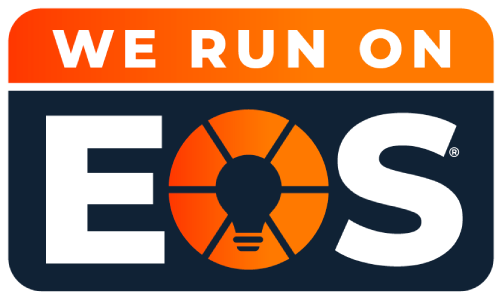The Entrepreneurial Operating System (EOS) is a powerful framework designed to help businesses achieve clarity, alignment, and traction in their operations. By implementing EOS, companies can overcome challenges, maximize opportunities, and drive sustainable growth. This structured approach to organizational management empowers businesses to operate more efficiently and effectively.
Implementing EOS Principles for Organizational Success
EOS principles offer several advantages for organizations striving for success in today’s competitive landscape. EOS encompasses several core components, each crucial for organizational effectiveness and success. Developed by Gino Wickman, EOS emerged as a holistic approach to business management, drawing inspiration from proven principles and practices.
Core Components of EOS
- Vision: Establishing a clear and compelling vision for the organization, including its core values, purpose, and long-term goals. A well-defined vision serves as a guiding light, aligning the efforts of all stakeholders and driving strategic decision-making.
- People: Ensuring that the right people are in the right seats within the organization, aligning their skills, strengths, and passions with the company’s vision and objectives. By fostering a culture of accountability and empowerment, organizations can unlock the true potential of their workforce.
- Data: Utilizing objective data to drive decision-making, measure performance, and enhance accountability. By leveraging data-driven insights, organizations can identify areas for improvement, track progress, and make informed strategic decisions.
- Issues: Identifying and solving issues at their root cause to maintain momentum and drive continuous improvement. By addressing underlying issues proactively, organizations can prevent recurring problems, minimize disruptions, and foster a culture of problem-solving and innovation.
- Process: Documenting and systemizing key organizational processes to drive efficiency, consistency, and scalability. By standardizing workflows and procedures, organizations can streamline operations, reduce waste, and enhance productivity.
- Traction: Instill discipline and accountability to execute the vision with precision. Through effective goal-setting, execution, and accountability mechanisms, organizations can ensure alignment, drive results, and maintain momentum toward achieving their vision and goals.

Steps to Implement EOS Principles Within Your Organization
Integrating Entrepreneurial Operating System (EOS) principles into your organization promotes clarity, alignment, and traction. We’ve provided essential steps for implementing EOS effectively, enabling you to realize your organization’s potential. These steps, from readiness assessment to vision creation, are crafted to ensure you confidently manage EOS implementation and achieve ongoing success. Below are the steps for EOS integration in your organization.
Assessing Readiness
Conduct a comprehensive assessment of your organization’s current state, including its strengths, weaknesses, and areas for improvement. Evaluate factors such as leadership effectiveness, team dynamics, and operational performance to determine readiness for implementing EOS principles.
Engaging key stakeholders, including leadership team members, department heads, and frontline employees, is crucial for successful EOS implementation. Their buy-in and support are essential for aligning the organization’s goals with EOS principles. Communicating the benefits of EOS and soliciting their input will ensure a smoother transition and increased chances of success.
Vision Building
Engage stakeholders in a collaborative process to define the core values that guide your organization’s culture and decision-making. Clarify your organizational purpose and articulate a compelling long-term vision that inspires and motivates stakeholders.
Craft a concise and impactful vision statement encapsulating your organization’s core values, purpose, and long-term aspirations. Ensure that the vision statement is easily understood, memorable, and actionable, serving as a guiding beacon for strategic decision-making and goal-setting.
Organizational Alignment
By ensuring that all leadership team members are aligned on the vision and core values, and by defining clear roles, responsibilities, and accountability within the organization, you can create a cohesive and high-performing team that drives towards your organization’s goals with precision and focus. Let’s explore these critical aspects of organizational alignment in more detail.
Implementing EOS Tools and Processes
Adopt and utilize the Entrepreneurial Operating System (EOS) essential tools and methodologies to integrate the principles into your company’s culture.
Employ EOS instruments such as the Vision/Traction Organizer (V/TO). These are designed to elucidate your company’s vision, delineate its fundamental values, and chart long-range objectives. Crafting a distinct and motivational V/TO enables you to synchronize your team’s efforts, propelling them towards achieving your business’s aims with precision and determination.
Instating consistent meeting cadences, including Level 10 Meetings and Quarterly Strategic Planning sessions, is vital for fostering execution and accountability within your company. These gatherings offer designated opportunities for teams to evaluate progress, address challenges, and synchronize on strategic imperatives, guaranteeing that all members collectively strive towards unified objectives with transparency and concentration.
Monitoring Progress and Adjusting Course
It is crucial to continually assess and refine your approach when implementing the Entrepreneurial Operating System (EOS) tools and methods. This process should include:
Determine which key performance indicators (KPIs) resonate with your company’s ambitions and consistently evaluate these indicators to gauge progress. Analytical data allows for educated adjustments and strategic pivots, ensuring that your business remains on a trajectory toward its defined goals.
Consistently scheduled EOS reviews are vital to gauge the vitality of your organization, pinpoint areas for enhancement, and maintain team coherence and motivation. These reviews offer a forum for discussing challenges, celebrating achievements, and reorienting tactics when necessary. This practice empowers your organization to be resilient and prosper in an ever-evolving market landscape.
Leveraging Fractional Talent for EOS Implementation and Alignment
As organizations implement Entrepreneurial Operating System (EOS) principles, leveraging fractional talent can provide invaluable support and expertise. Here’s how fractional talent can facilitate alignment and drive success in EOS implementation:
Types of Fractional Roles That Can Support EOS Implementation
- Integrator: The Integrator role ensures that the leadership team’s vision is executed effectively throughout the organization. Integrators oversee day-to-day operations, drive accountability, and ensure all departments work together towards common goals.
- Implementer: Implementers are crucial in translating the organization’s vision and goals into actionable plans and initiatives. They are skilled at project management, execution, and driving results, ensuring that strategies are implemented effectively and efficiently.
- Facilitator: Facilitators help facilitate meetings, workshops, and training sessions related to EOS implementation. They ensure that discussions are productive, issues are addressed, and decisions are aligned with EOS principles. Facilitators also help build consensus among team members and drive buy-in for EOS initiatives.
Identifying the Right Fractional Talent
To leverage fractional talent effectively, organizations must first assess their needs and gaps in expertise. This involves identifying areas where additional support is needed to drive EOS implementation forward and address any challenges or obstacles.
Once you’ve identified your organizational needs, the next step is to select fractional talent with relevant experience and expertise in EOS implementation. This includes individuals who have a deep understanding of EOS principles and hands-on experience implementing EOS within organizations of similar size and complexity.
By selecting fractional talent with the right skills, experience, and expertise, organizations can ensure they have the support they need to successfully implement EOS and drive alignment, accountability, and results. Ready to get started? Contact us to learn more!





Reader Interactions